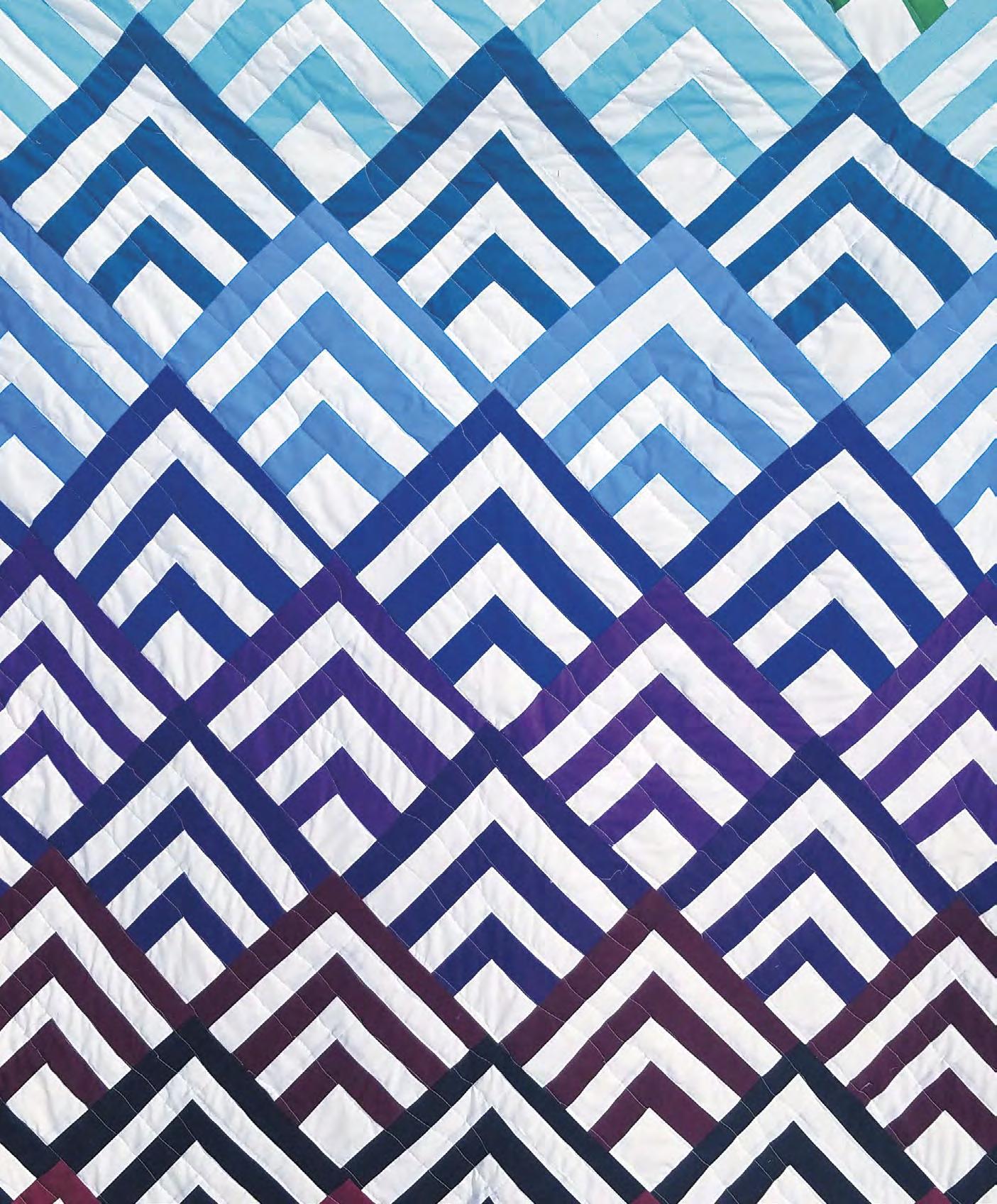
6 minute read
Choate Remote
Creatively Adapting to COVID-19
By Brianna St. John
The past year has truly been an exercise in creativity for Choate Rosemary Hall, both on and off campus. Faced with the physical limitations of COVID-19, faculty, staff, and students had to rethink every element of their daily experiences: how to learn and work, how to navigate physical spaces, and how to share and express joy when daily routines changed so significantly. Though the pivot to online learning in March 2020 was unexpected, it became the foundation through which the Choate community would continue to unite. By integrating technology and creativity, the community has continued to come together to make sense of this new normal, celebrating endeavors while we are not yet completely reunited.
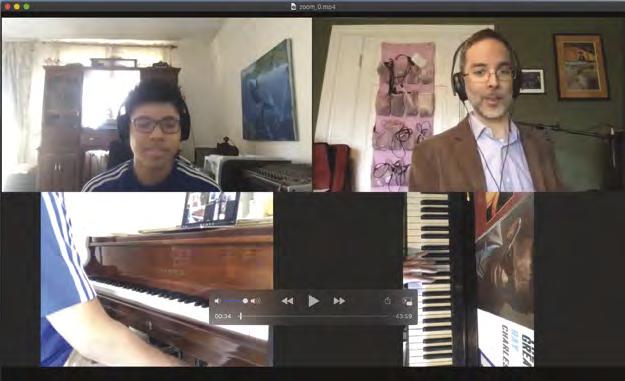
Noah Baerman stays connected with his students, teaching jazz piano lessons virtually.
Leaning Into Remote Creativity
There is both a solitary and social quality in creativity. While artistic expression can be a deeply personal and therapeutic one, coming together to share in the creative process allows us to communicate beyond borders and screens: it reminds us that we are a community. The act of sharing creative endeavors allows us to craft a common language around our joys and sorrows, our successes and setbacks – something crucial through a pandemic that has isolated so many. It is through this communal creativity that Choate has allowed the spirit of the campus to thrive beyond the borders of Wallingford, allowing students, faculty, and staff alike to reunite around a culture of cohesion and shared experiences.

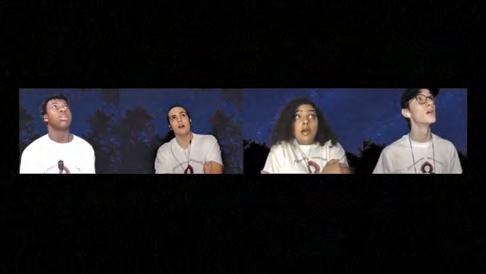
Dominic Thomas ’21, Wylie Doak ’22, Skye Figueroa ’22, Gregory Stone ’23, and Ryan Kim ’23 star in the student production Take-Away, streamed to the Choate community this winter.
This connection wouldn’t be possible without a robust array of technological offerings. Choate’s pivot to online learning in March 2020 saw students and adults alike embracing iPads, Zoom rooms, and Virtual Student devices while swapping desktops for laptops to make way for remote and synchronous access to classes and office responsibilities. This integration of technological and creative resources is perhaps best seen in the programming offered by the Arts Department, particularly during the winter months.
Take, for example, the most recent student production, Take-Away. The play (written collaboratively by English teacher Kate Doak, Ethan Bardoe ’21, Maxwell Brown ’21, Audrey Lim ’23, Eliza Marovitz ’21, Sabrina Carlier ’21, and Yasemin Cobanoglu ’21) centers on high school senior Charlie, who disappears the night before graduation. The culprits? None other than fast-food-loving aliens. Beyond a fun story, students leaned into the limitations set by COVID restrictions and physical distancing, building the use of Zoom into the fabric of the play itself, even telling the story through recorded Zoom calls. Students made clever use of custom backgrounds, video edits, and the now well-known phenomena of Zoom-bombs and call-drops to reflect the New Normal of 2020 in the performance. They took the technology of their academics and applied it to their creative endeavor, bringing the play to life in a way that respects COVID limitations without losing the communal sense of creativity.
But the desire to reunite through creativity extends beyond the scope of extracurricular activities. Once more, the Arts Department utilized the merger of technology and artistic expression to allow this reunion to take place. When Choate first moved to remote learning, Arts Department staff put out a call for members of the community to share their artistic creations on the choate_arts Instagram, a virtual gallery of projects from staff, faculty, and students. Crafters, singers, painters; poets and sculptors; beginners and seasoned creators alike submitted their songs, stories, paintings, quilts, sculptures, and other crafts.
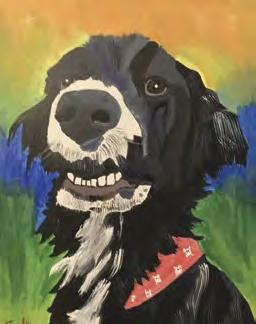
Lindsay Amenta from Human Resources shares her painting with choate_arts Instagram.
The gallery became a celebration of the creativity found by those still at home, taking the solitary act of creating and allowing it to become a shared experience bringing friends together. The result was an influx of color, texture, song, and rhythm, all of which invited students and adults to engage outside of a strictly academic or workplace setting. In moments where there were no walks between classes or quick catch-ups while getting coffee, the community could still find joy in creating, and could share that joy together in a new way.

Tenzin Bista ’23 sews masks as part of a Community Service project.
Creatively Adapting
While the Arts Department provided ample space for artistic expression and sharing, the spirit of creativity didn’t end with art alone. Other departments embraced this opportunity for change, adapting to the realities of COVID restrictions in engaging new ways.
Community service is a perfect example. Giving back and connecting to the community is a large part of a Choate experience, one that was limited by physical distancing requirements and the potential for contamination in off-campus spaces. It was through the continued integration of technology and creativity that students were able to continue their community service endeavors. Melissa Koomson, Director of Community Service, worked with students to sew masks and donate knit hats and gloves to Loaves and Fishes, a New Haven–based nonprofit that provides food and clothing to those in need. Students made use of reconfigured spaces to allow for physical distancing while they worked to cut fabric, sew masks, and knit and weave products for donation. Student volunteers from Choate’s Interact Club also hosted storytime on Zoom for youth in grades K–12 as part of Reading Buddies, a virtual program sponsored by the Wallingford Public Library. These activities allowed students to still give back while utilizing technology in a way that fostered connection beyond campus.
In the Admission Department, creativity came in the form of new methods of communication. In having to rethink Spring Visits, where prospective students traditionally come to explore the campus as part of their application process, the Admission team turned to creative uses of technology. With the help of the Communications Department, visits to campus went digital: videos giving detailed walk-through tours of buildings and favorite outdoor spaces were paired with behind-the-scenes photos to give new students an insider’s view at what life at Choate would look like. The Admission team also recorded exclusive Choate Chat videos, giving students in-depth information about topics ranging from what the typical day student experience is like, to interviews with upperclassmen, to talks with international students. This year will also find faculty and staff members participating in panels discussing their areas of expertise, once again giving incoming students a unique connection to campus while they are still remote.
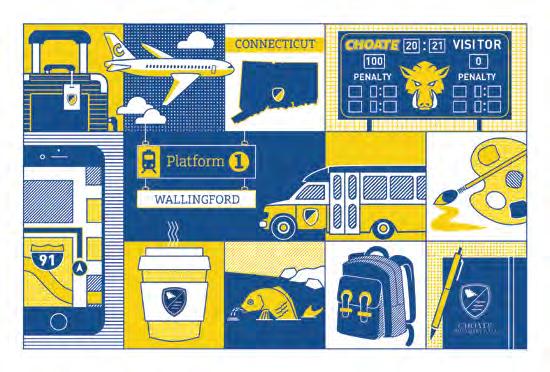
Choate awaits! Destination Choate was the unifying theme of this year’s Spring Visits programming with the Admission team.
In using videos and digital applications this way, the Admission team was able to take the heart of the Choate experience – the idea of community and cohesion – and share it with all prospective students, introducing them to the most Choate-like experience possible while still prioritizing the safety of the campus community. This approach also had the unanticipated benefit of granting all applicants equitable access to Admission programming, regardless of their ability to get to campus.
Keeping Choate Whole
In a year when so much emphasis has been placed on limitations – physical distancing, increased caution, the need to stay apart – Choate focused on togetherness. The move to remote learning necessitated the need for huge technological advances in a short amount of time, but it’s what the community did with those tools that remains the most impressive.
It was the creativity of the campus that has truly kept the community together. The Choate experience is not limited to academic success, and this year has shown that technology is but one avenue for connectivity through the pandemic. It is through shared experiences, a supportive and collaborative culture, and a willingness to learn that the true heart of Choate reveals itself. It is seen in the School’s ability to adapt to change; in students who embrace a new academic landscape; in faculty who learn and try new methods of teaching; in staff and facilities crews who ensure that the campus has the resources and information it needs to thrive. And most important, it is seen in the desire to share ideas. Through art and technology alike, the School embraces the notion of communal creativity, allowing Choate to grow beyond the borders of campus and Wallingford. In looking at how the community adapted, one can’t help but ask: what exciting changes will Choate make next?


